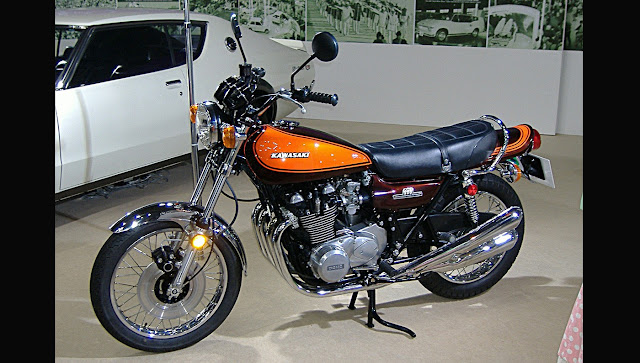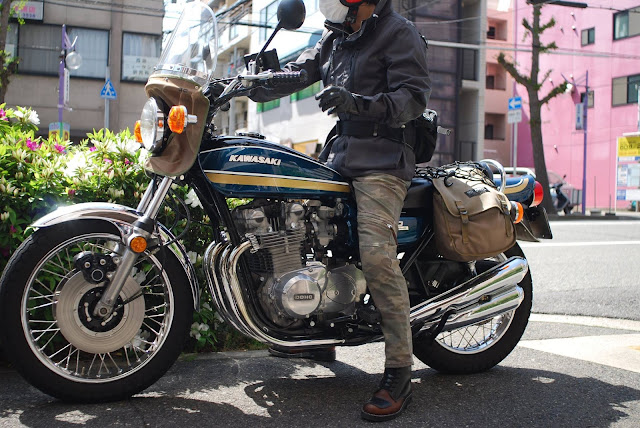Kawasaki Z1
As well as being by far the world's most powerful production motorcycle, the Z1 was a handsome machine that screamed power and speed despite its high handlebars and a thick dual seat. This 1974-model Zl-A differs from the previous year’s original Z1 in its paint scheme and alloy, instead of black, engine finish.
They called it the King, and in the mid- 1970s there was no disputing that Kawasaki’s Z1 ruled the roads. When the 903cc four was launched in 1973, its top speed of over 130mph (210km/h) put the new bike lOmph (16km/h) ahead of Honda’s CB750, its closest challenger. The Kawasaki was also more than a second quicker through the standing quarter mile, and just happened to be good-looking and very reliable too. No wonder it was an instant smash hit.
The Z1 ’s early story is one of triumph over near disaster. Kawasaki originally intended to build a 750cc four, and was close to completing work on the project, codenamed New York Steak, when Honda unveiled the CB750. Once the initial disappointment had faded. Kawasaki’s engineers realized that they now had the advantage of knowing what they had to beat. They enlarged their own engine to 903cc, and returned four years later to do just that.
There was never any doubt that the Z1 engine, which featured twin overhead cams, working eight valves via bucket-and-shim adjustment, would have a substantial advantage over the smaller, sohc CB750 unit, which had changed little in the meantime.
With a maximum output of 82bhp at 8500rpm, the Kawasaki motor was 15bhp more powerful, and produced considerably more low-rev torque too. It sat near vertically in a twin-downtube frame whose forks held a 19-inch wheel and single disc brake.
If the Zl’s chassis specification was nothing out of the ordinary, its styling gained some extra advantage. Although the Kawasaki was undeniably big and heavy, weighing 5421b (246kg) with fuel, it was very well proportioned. Its curved fuel tank, small sidepanels and rear duck-tail behind the dual seat gave a stylish, vibrant look that was totally in keeping with its performance.
Not that the riders of any other bike got to see more than the back of the fast-disappearing Zl on the road. Its acceleration was brutal by contemporary standards, with the big twin-cam motor churning out smooth, strong torque throughout its rev range. There was plenty of scope to make it faster still, too, as many tuners and racers soon confirmed.
Handling was a different matter. In normal use the Zl gave no problem, and was even fairly comfortable despite its high handlebars. Pushed harder, the awesome motor was sometimes too much for the chassis, causing high-speed instability. Many owners fitted steering dampers and aftermarket rear shocks, which helped. Better still was a frame kit from a specialist such as Harris, Martin, Egli or Bakker.
Most owners found the Zl plenty good enough as it was. Such was its performance lead that Kawasaki’s only changes for the first two years were cosmetics and minor details. In 1976 a second front disc brake, previously an optional extra, became standard fitment, while smaller carbs and more restrictive pipes (to reduce emissions for the US market) reduced peak power slightly. The bike also gained a new name, becoming the Z900. One other thing didn’t change: its status as the twowheeled King of the road.
A Faster Four - The Z1-R
Kawasaki's answer to increased challenges from rival Japanese *ours m 19^8 was the Z1-R, an uprated version of the current Z1000. The most ob.ious change .vas the bikini fairing, whose angular lines were echoed in the fuel tan< and bodywork. The standard 1015cc engine remained, but bigger carbs a^d a *our- into-one pipe increased output by 6bhp to 90bhp. Chassis updates nclucec a braced frame, retuned suspension, cast wheels and revamped brakes. Top soeeo was increased to 130mph (209km/h), and the fairing boosted high-speec comfort, though not stability. Handling at lower speeds was marginally bette' too. Overall this was the best big Kawasaki yet.
Specification Kawasaki Z1 (1973)
- Engine Air-cooled dohc eight-valve four
- Capacity 903cc (66 x 66mm)
- Maximum power 82bhp @ 8500rpm
- Transmission Five-speed, chain final drive
- Frame Steel twin downtube
- Suspension Telescopic front; twin shocks rear
- Brakes Single disc front; drum rear
- Weight 542lb (246kg) wet
- Top speed 132mph (212km/h)





















0 comments: